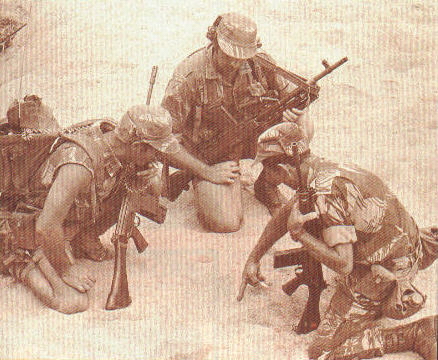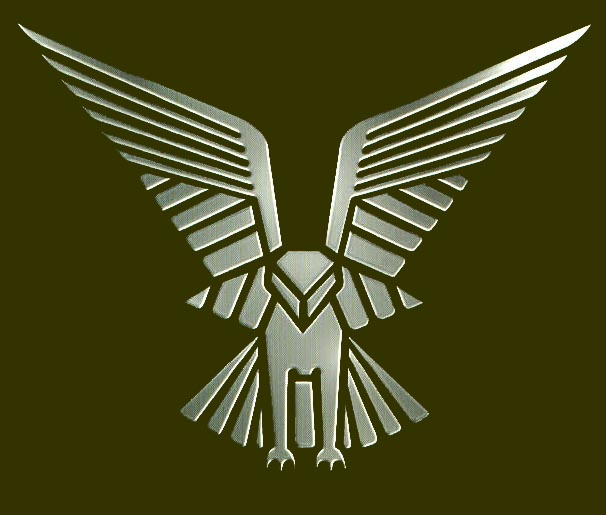|
As the Land-Rover rounded a corner
on the long, dusty road near Fort Victoria, Rhodesia (now Zimbabwe), my
attention froze on a large free lying across the road. Slamming on the
brakes and counter-steering a skid, we came to rest about two meters
from the obstacle. Then the ambush was sprung.
"The old tree across the
road followed by an ambush trick,” I thought. “Hope they forgot the
Claymore! Glad they forgot the land mine!” Reacting instantly with
counter fire is what saved our lives, because it had the ZANU (Zimbabwe
African National Union) terrorists already fleeing before we dismounted.
Honest to God, it looked like the Olympic 100-meter finals viewed from
the south end of the stadium. The after action silence made It feel like
the ambush never happened. After quickly reorganizing, we were happy to
find no casualties. Already, only about a minute after the encounter,
the enemy was hundreds of meters away —
with no sign of slowing down.
Organizing ourselves into a
follow-up group took only seconds, and leaving a security group to look
after the vehicle, we moved out. But where to? And to do what? How could
we possibly catch up with an ambush group that melted so fast into the
bush? Tracking, my friends, tracking. Tracking is the skill (some call
it an art) of pursuing the enemy by following the signs he leaves
behind. For in their haste to flee our counter fire, they left
enough clues to allow us to follow them. And follow we did. And not only
follow them, but catch up with them, and kill them.
Now, how do you track? How do
you read the signs the enemy leaves behind? Sign (or spoor) falls into
two main categories: ground spoor and aerial spoor.
Ground Spoor, as the name
implies, is sign found on the ground. Examples are footprints, disturbed
earth, overturned rocks, etc. Aerial spoor is found above the ground
in the form of trampled grass, broken bushes, broken cobwebs, etc.
(Maybe your mother wears combat boots, but mother nature doesn’t —
look for any signs which nature does not make).
Upon locating tracks, we need to
study them to learn at least three things:
1. Approximate number in the group.
2. Age of the spoor.
3. Direction of travel.
Determining the number in the
group is accomplished as follows:
1. Measure off 30 inches (or the length of one
stride) along the tracks between two points.
2. Draw two lines at right angles to the tracks at
those two points.
3. Count the number of footprints between the lines
— this will give you the number
of people who have passed through the area.
This technique is very simple, but
it only works accurately up to about 10-12 people.
Estimating the age of a
footprint is a little harder. Tracks, especially human footprints, lose
their sharp edges over time because of wind, rain and sunshine. Wind
erodes the prints, rain washes them out and the sun dries prints
that are in mud. It is especially important to consider what the weather
was like over the past few days to judge the age of the spoor
accurately. Has it rained recently? How much did it rain? Has it been
windy?
Age of aerial spoor can be judged by
the state and position of trodden vegetation. Long grass, for example, is resilient and will spring back after
being walked on. Also, the juice inside the blades will make freshly
trodden long grass somewhat damp. If such grass is completely dry when
you come upon it, the spoor is obviously not fresh. Unfortunately, only
practice and experience will teach you how to judge the age of tracks
accurately.
Direction of travel is
determined with a compass. However, don’t be fooled into thinking that
the initial line of travel won’t change. It will usually take about
two kilometers to accurately determine the true direction.
Now that we have recognized tracks,
estimated the number of enemy, know how much of a head start they
have, and know the general direction of travel, we can deal with how to follow tracks.
Before moving out, it is
important to find an actual footprint or boot print. We call this
“confirmed spoor.” Aerial spoor is not confirmed spoor. Ground spoor
that is not an actual print of a boot or foot, like overturned rocks,
crushed leaves, etc. is not confirmed spoor either. So the rule is to
start out on confirmed spoor.
The tracker must memorize the characteristics of the prints (tread
pattern, if any, and size), which he encounters so that he doesn’t
become confused later if he encounters a different set of tracks.
Track with your head up and look
about 10 feet in front of you. New or inexperienced trackers typically
look at the ground nearer their feet and tend to miss tracks farther
away. This tends to slow the rate of tracking. Remember this: You
must track at a faster pace than the enemy is walking if you want to
catch up with him.
Do not walk directly on the
spoor, but rather to the side, so as not to obliterate it.
It is easier to track into the sun,
than with it at your back This is because the sun casts a shadow on the
indentations of the boot print, making it easier to see. When tracking
away from the sun, this shadow cannot be seen so what you do is to track
alongside of the spoor and occasionally look over your shoulder,
down at the spoor. This gives you the same view as if you were tracking
into the sun.
While tracking, the tracker must
be constantly alert for booby traps and possible ambush sites, If your
tracking is successful, at some point you will be catching up with the
enemy, and it’s not a good idea to be caught off guard. Possible
ambush sites should be cleared before passing near them. Examples are
small hills, thick bushes, narrow defiles, etc.
Occasionally, due to the nature of the ground, lime
of day (tracking at noon casts little or no shadow) or tracker fatigue,
the tracks will be lost Now what?
Go to the last confirmed spoor
and draw a line behind it, across the tracks. Stand behind the line,
take time to survey the landscape in front of you, then ask yourself
“Where would I go if I were walking along here?” Look for the
logical line of advance, and then go check it out If you find the spoor
again, continue to track. If not, go back to your line and do a 3600
circle. It goes like this: Using your last confirmed spoor as your
starting point, walk 15 meters forward and walk in a circle around your
point looking for tracks. Keep enlarging this circle until tracks are
found, then continue tracking.
Sometimes, you may run out of
available light at the end of the day. In this case, you have to sleep
on the spoor and continue in the morning, obviously starting at
first light.
The skill of tracking is
valuable because a group with the ability to track and read tracks can
engage enemy units that they otherwise could not It only stands to
reason, then, that an understanding of this skill will also enable them
to better hide their own tracks when on patrol. And that brings us to
anti-tracking — how to avoid
being the trackee.
Though it is virtually
impossible to avoid leaving spoor, certain techniques can be employed to
minimize detection. The aim is to make the job of the enemy tracker as
hard as possible and maybe you’ll be lucky enough that your
anti-tracking techniques will defeat his tracking ability. However, keep
in mind there are those who can track you no matter what techniques you
employ. In such cases, since you can’t outwit the enemy tracker, you
can buy yourself some time through deception and a consistently fast
rate of march that will keep you one step ahead. Hopefully you will
avoid contact until dusk, at which lime he will literally have to stop
dead in your
tracks. You, on the other hand, continue to make tracks, but in a
night march, slipping farther away in the process.
Let’s look at some proven
anti-tracking techniques. First, examine the sole of your boot
Vibram soles and jungle boots are a Christmas present to a good tracker.
If you have no choice as to your boots, tie a sandbag over them to cover
the tread pattern. A smooth sole is naturally harder to track than a
cleated one. In Africa we were issued a high-topped, smooth-soled boot
called “boots clandestine” and they worked very well.
Second is patrol technique. Try
at every opportunity to walk on ground that is hard or rocky, double
back, split into groups, change boots, or take them off and walk
barefoot for a while. This can throw off, slow down or confuse a
tracker, even a good one. One of the best ways to avoid being tracked is
to kill the tracker! Sniper fire, a well-placed booby trap, or doing a
dogleg and ambushing your own tracks will definitely take the fighting
edge off a follow-up group.
Tracking and anti-tracking are
skills that are difficult to learn but very much worth the effort.
Practice definitely makes for proficiency. At limes your patience and
perseverance will be tested because you might be on tracks for days only
to have them “disappear” into thin air. Learning these skills can
breathe a lot of confidence into individual soldiers as it helps them.......
(NOTE; End of this article was lost I will post it
as soon as I can find another copy of it.)
|

|




